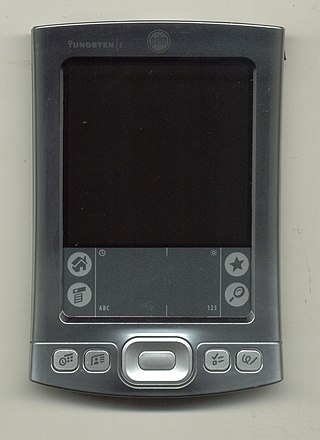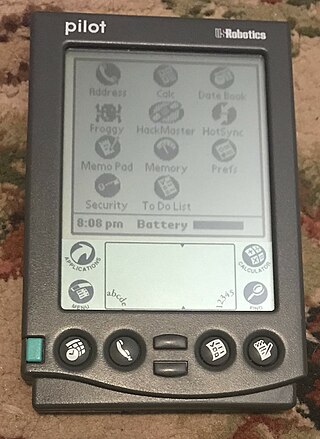
A personal digital assistant (PDA), also known as a handheld PC, is a multi-purpose mobile device which functions as a personal information manager. PDAs have been mostly displaced by the widespread adoption of highly capable smartphones, in particular those based on iOS and Android, and thus saw a rapid decline in use after 2007.

A wearable computer, also known as a body-borne computer, is a computing device worn on the body. The definition of 'wearable computer' may be narrow or broad, extending to smartphones or even ordinary wristwatches.

Palm is a line of personal digital assistants (PDAs) and mobile phones developed by California-based Palm, Inc., originally called Palm Computing, Inc. Palm devices are often remembered as "the first wildly popular handheld computers," responsible for ushering in the smartphone era.

A smartphone is a mobile device that combines the functionality of a traditional mobile phone with advanced computing capabilities. It typically has a touchscreen interface, allowing users to access a wide range of applications and services, such as web browsing, email, and social media, as well as multimedia playback and streaming. Smartphones have built-in cameras, GPS navigation, and support for various communication methods, including voice calls, text messaging, and internet-based messaging apps.
The Zire Series was Palm, Inc's "consumer-grade" brand of Personal Digital Assistant.

The Tapwave Zodiac is a mobile entertainment console. Tapwave announced the system in May 2003 and began shipping in October of that same year. The Zodiac was designed to be a high-performance mobile entertainment system centered on video games, music, photos, and video for 18- to 34-year-old gamers and technology enthusiasts. By running an enhanced version of the Palm Operating System (5.2T), Zodiac also provided access to Palm's personal information management software and many other applications from the Palm developer community. The company was based in Mountain View, California.

The Tungsten series was Palm, Inc.'s line of business-class Palm OS-based PDAs.
The Samsung SPH-i500 was a Palm OS-based smartphone manufactured by Samsung Electronics. It was previewed at CommunicAsia 2002 in June and launched later that year. It was later discontinued in August 2005. It was marketed in the United States for use on Sprint's mobile phone network.
The Ruputer is a wristwatch computer developed in 1998 by Seiko Instruments, a subsidiary of the Seiko Group. It was introduced on 10 June 1998. In the US, it was later marketed as the onHand PC by Matsucom.

The Pilot 1000 and Pilot 5000 are the first generations of PDAs produced by Palm Computing. It was introduced in March 1996.
The Palm m500 series of handheld personal digital assistants consisted of three devices: the Palm m500, Palm m505, and Palm m515. The series was a follow-up to the popular Palm V series with a similar, though slightly shorter, footprint and form factor.

The Palm m100 series consists of four Palm OS based personal digital assistants titled m100, m105, m125, and m130. These models were intended to be "entry-level" PDAs, and therefore their cases were built from cheaper materials. Most notably, the covers of the LCD screens and the digitizers were plastic rather than glass, and the screens were smaller than the more expensive Palm devices on sale at the time.

Pen computing refers to any computer user-interface using a pen or stylus and tablet, over input devices such as a keyboard or a mouse.
Handspring, Inc., was an American electronics company founded in 1998 by the founders of Palm, Inc., after they became dissatisfied with the company's direction under the new owner 3Com. The company developed Palm OS–based Visor- and Treo-branded personal digital assistants. In 2003, the company merged with Palm, Inc.'s hardware division.
The history of tablet computers and the associated special operating software is an example of pen computing technology, and thus the development of tablets has deep historical roots. The first patent for a system that recognized handwritten characters by analyzing the handwriting motion was granted in 1914. The first publicly demonstrated system using a tablet and handwriting recognition instead of a keyboard for working with a modern digital computer dates to 1956.

A smartwatch is a portable and wearable computer device in a form of a watch; modern smartwatches provide a local touchscreen interface for daily use, while an associated smartphone app provides management and telemetry, such as long-term biomonitoring. While early models could perform basic tasks such as calculations, digital time telling, translations, and game-playing, smartwatches released since 2015 have more general functionality closer to smartphones, including mobile apps, a mobile operating system, and WiFi/Bluetooth connectivity. Some smartwatches function as portable media players, with FM radio and playback of digital audio and video files via a Bluetooth headset. Some models, called watch phones, have mobile cellular functionality such as making telephone calls.

The Chromebook Pixel is a 2013 laptop at the high end of Google's Chromebook family of machines, which all come preinstalled with ChromeOS operating system. The Chromebook Pixel is part of the Google Pixel series of consumer electronics. An updated model was released in 2015. Chromebook Pixel stopped receiving software and security updates in August 2018.

The Pixelbook is a portable laptop/tablet hybrid computer developed by Google which runs ChromeOS. It was announced on October 4, 2017, and was released on October 30. In September 2022, Google canceled future generations of the product and dissolved the team working on it.

The Pixel Slate is a 12.3-inch tablet running ChromeOS. It was developed by Google and released on October 9, 2018, at the Made by Google event. In June 2019, Google announced it will not further develop the product line, and canceled two models that were under development. The Pixel Slate was removed from the Google Store in January 2021.















